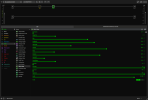Orvillain
Power User
Sorry in advance. I know these topics can sometimes get a bit heated. I don't mean to besmirch the Axe3.
But there's an effect on Helix called 'Glitch Delay' which I've really been digging.

So you've got a digital delay.... you set a time value .... and the algorithm from what I can tell ... divides that buffer up based on the delay division parameter. These slices have their own feedback value, and the playback order of them can be shuffled, you can bring in an octave up+down shift effect in there somewhere too... and also a reverse delay. The internal sequencer can be set to drift, and the whole thing can be smoothed out to create these really dense textures.
Axe3 is definitely capable of dense textures. But does anyone know how we might replicate the Glitch Delay??
But there's an effect on Helix called 'Glitch Delay' which I've really been digging.

So you've got a digital delay.... you set a time value .... and the algorithm from what I can tell ... divides that buffer up based on the delay division parameter. These slices have their own feedback value, and the playback order of them can be shuffled, you can bring in an octave up+down shift effect in there somewhere too... and also a reverse delay. The internal sequencer can be set to drift, and the whole thing can be smoothed out to create these really dense textures.
Axe3 is definitely capable of dense textures. But does anyone know how we might replicate the Glitch Delay??

